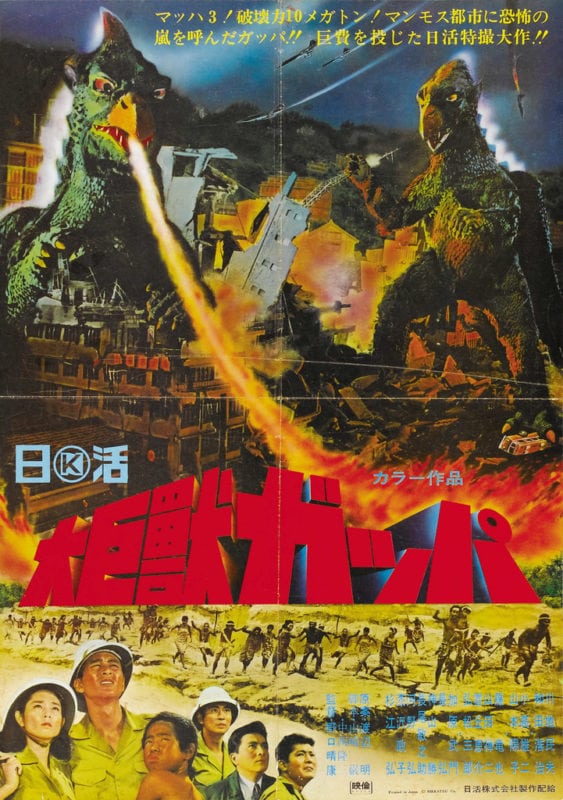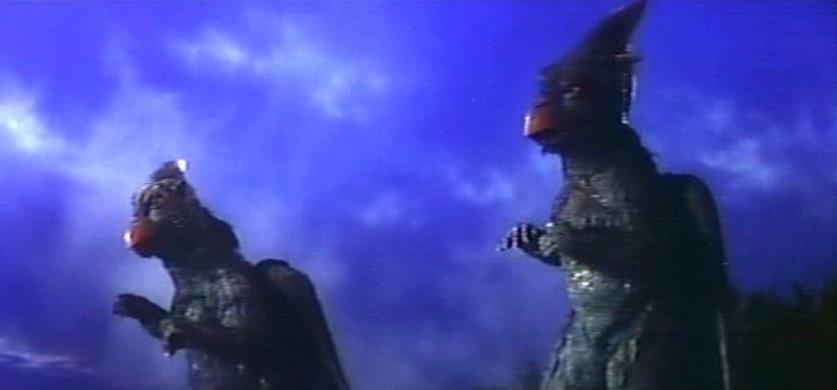Gappa: The Triphibian Monsters (1967)
Directed by: Haruyasu Noguchi
Written by: Gan Yamazaki, Ryuzo Nakanishi
Starring: Kôji Wada, Tamio Kawaji, Yôko Yamamoto, Yuji Okada
HCF REWIND NO. 185: GAPPA: THE TRIPHIBIAN MONSTERS AKA DAIKYOJU GAPPA, COLOSSAL MONSTER GAPPA, MONSTERS FROM A PREHISTORIC PLANET [Japan 1967]
AVAILABLE ON R1 DVD
RUNNING TIME: 90 min
REVIEWED BY: Dr Lenera, Official HCF Critic
Magazine writers Hiroshi Kurosaki and Sanbuto Hayashi, and photographer Itoko Koyanagi, with whom both men are in love, are, along with a group of university scientists, searching the South Seas looking for exotic animals. Their boss, publishing magnate Funazu, is branching out into the tourist trade and wants to create a huge South Seas attraction in Japan. After surviving an underwater volcanic eruption, they see a huge statue on an island and go to investigate. Despite the protestations of a native boy, Hiroshi and Sanburo go into a forbidden area and enter a cavern where a baby monster hatches from an egg. They take the creature away, even though the natives don’t want this. Why? Because it seems that the young monster has two Godzilla-sized parents…..
This rather sloppy but charming Japanese monster movie is essentially a remake of the British 1961 monster movie Gorgo, where a baby monster is taken to London and its mother appears and wants her kid back, causing much destruction in the process, while also working in a few elements of Mothra and even King Kong, or rather King Kong Vs Godzilla. Therefore the story isn’t original whatsoever, while the human drama is awkward and the whole film has a bit of a slapdash feel to it, especially with regard to its special effects, where they obviously didn’t have enough money to make everything look good and struggled. It’s still good fun for fans of this type of movie though, with pretty much constant action for the final hour and a rather sincere kind of sweetness which is very appealing. I’m usually one of those people who is more on the side of the monsters than the humans in this kind of film anyway, but I especially love ones with this particular kind of story, because I’m totally rooting for them, here both a mother and a father, trying to get their kid back. The film was obviously intended as a partial satire of the whole genre, though I don’t think this always comes across, at least in the R1 DVD from Tokyo Shock, which contains the Japanese language version but has its subtitles copy exactly the words of the English language dub track.
It was not actually made by Toho Studios but came from Nikkatsu, during a short period where some of Japan’s other studios tried to get in on the act, though only Daiei managed to create an actual franchise with their movies starring the giant flying turtle Gamera. You’ll no doubt be thrilled to know that I’ll be reviewing those films in the future. Gappa: The Triphibian [meaning they can walk, swim and fly!] Monsters was Nikkatsu’s only monster movie, though its special effects were by Akira Watanabe, who worked as an art director on some of Toho’s older classics. The overseas prints, which were sometimes called Monster From A Prehistoric Planet [had the distributors seen the film?] replaced the opening and closing song with an instrumental cue and a ballad near the end of the film with an instrumental version of the same song, but were uncut. It was claimed that the English language version originally had a racist line: “The monsters are attacking Tokyo, fortunately they are attacking the Negro section of town”, which was then altered to:“…attacking the poor section of town”, but it was actually: “attacking the Nikko region”, a certain area of Japan famed for its beauty and large amount of ancient shrines and temples. The film was successful in Japan and every now and again there have been rumours that the family Gappa will return, though nothing has materialised yet.
The story doesn’t waste much time getting to the island, though there is a shipboard scene that makes no sense whatsoever. We see two glowing lights in the water, and somebody says that they saw a monster, but at this point in the story the monsters, even if they are Gods to the natives, are still trapped in a cave until a landslide caused by an erupting volcano frees them…but then what have they been living on for thousands of years? You’ll obviously not meant to think too much about such things, but Gappa has several such unexplained aspects, like a briefly seen Gappa-like bird seen in a jungle. The creature is never spoken of again. While the film is certainly partly tongue-in-cheek, you’ll probably not intended to laugh at things like the natives clearly being Japanese folk painted to look darker, or the overall roughness of the movie, which is full of awkward cuts between scenes and has rather weak direction by Haruyasu Noguchi. The general level of filmmaking is mediocre and the film lacks the smoothness and sheen of even Toho’s weaker efforts. And, at least in the afore-mentioned DVD, some of the translated dialogue is plain weird, like a conversation about a “burnt lizard”. I hope that one day we can get to see a subtitled version that is taken from the actual Japanese language track rather than the dub, because the dialogue would be far improved and perhaps the humour would work better too.
Anyway, we’re watching this film mostly for the monsters, and after about a third of the way through we meet the baby Gappa, hatching from his egg with no attempt made whatsoever to disguise the fact that it’s a man in a suit – for God’s sake you can even see that the guy is on his hands and knees. After he is taken to Japan, the two parents follow, and I have to say that these bird-reptiles look quite ridiculous with their beaks and wings which seem to get in the way of their arms. However, this is just the kind of absurd monster design that helps make the whole Japanese kaiju eiga genre so unique. Sod realism, let’s just make something that is imaginative and visually interesting. The Gappas possess both Godzilla-type death rays and Rodan’s ability to cause buildings to crumble by flapping their wings. Their city stomping and battles with the military suffer somewhat from poor detail in the miniatures, and a few bits are just embarrassing, like an underwater scene that is so obviously filmed on a dry set, but there are some impressive bits to compensate, like a rampage through the factory area that Hedorah, Ghidorah and Gigan would later lay waste too, and some humorous images, like one of the Gappas emerging from the water with an octopus in its mouth. There’s certainly plenty going on, with two volcanoes, one underwater, erupting, an earthquake and a tidal wave thrown in alongside the monster stuff. The tale has an emotional charge to it, meaning that the final reuinion scene on an airport runway [a la Mothra] is genuinely touching, aided immensely by the moving song that plays, a vocal version of the lovely theme for the baby Gappa which is by far the best part of the otherwise forgettable score by Seitaro Omori, which fails to score many important scenes and lacks the flair of Akira Ifukube’s or Masaro Sato’s Toho work.
The human drama only works sometimes. This is partly because it’s so rushed. The love triangle is given such short shrift it would have been better not bothering with it, and ends in a distinctly un-feminist manner with Itoko, seemingly inspired by the parental monster love she has just witnessed, quitting her job, walking away from her two suitors and repeating a line from earlier: “I guess I’m just an ordinary woman, I should stay at home, marry an office worker and change diapers”. I don’t if this is meant to be ironic or to be taken seriously, but I’m more inclined to think the latter. Then there’s the greedy publisher Funazi, whose young daughter Aihara clearly wants the housemaid to be her new mother, and of course Aihara’s attachment to baby Gappa. The scientists and the reporters are at odds over what to do with the infant, while the native boy Saki also ends up in Japan after the natives have fled their island due to the angry parents, and also befriends the infant creature. None of this subplot stuff is given enough time to breath. Obviously you don’t want too much time spent on it as it would slow the movie down too much, but I could have done with more scenes, for instance, of the two kids with the baby Gappa. Said animal doesn’t register enough as an actual character and isn’t even shown clearly very often. Just think of how, for instance, Mothra so well established the plight of the Shobijin and made us care about them while still building tension. Gappa’s story still basically works because of its very nature, but it could have worked far better than it does.
The cast are mostly okay if undistinguished, though Masanori Machida as Saki is cute despite his blackface and Afro wig, while if you’ve seen In The Realm Of The Senses you may recognise Tatsuya Fuji in there. One annoying short character exists in the early scenes simply to be clumsy and fall over. There are lots of flaws with this very rushed-seeming movie, and it really shows up how good Toho was at this kind of thing by comparision, though it’s possible that Nikkatsu could have got better at monster movie making if they’d made some more. It’s very likeable though, and has real heart to it, unlike, for instance, the lame 1998 American creature feature for some reason named Godzilla that I recently reviewed for this website!
Rating: 














Be the first to comment